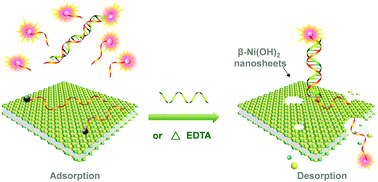当前位置:
X-MOL 学术
›
J. Mater. Chem. B
›
论文详情
Our official English website, www.x-mol.net, welcomes your feedback! (Note: you will need to create a separate account there.)
β-Ni(OH)2 nanosheets: an effective sensing platform for constructing nucleic acid-based optical sensors
Journal of Materials Chemistry B ( IF 7 ) Pub Date : 2017-08-14 00:00:00 , DOI: 10.1039/c7tb01389b Hui Zhou 1, 2, 3, 4, 5 , Junbin Peng 4, 5, 6, 7 , Xinlan Qiu 1, 2, 3, 4 , Yansha Gao 1, 2, 3, 4 , Limin Lu 1, 2, 3, 4 , Wenmin Wang 1, 2, 3, 4
Journal of Materials Chemistry B ( IF 7 ) Pub Date : 2017-08-14 00:00:00 , DOI: 10.1039/c7tb01389b Hui Zhou 1, 2, 3, 4, 5 , Junbin Peng 4, 5, 6, 7 , Xinlan Qiu 1, 2, 3, 4 , Yansha Gao 1, 2, 3, 4 , Limin Lu 1, 2, 3, 4 , Wenmin Wang 1, 2, 3, 4
Affiliation

|
In this study, beta nickel hydroxide (β-Ni(OH)2) nanosheets, one of the transition metal oxyhydroxides with two dimensional (2D) structures, were explored as a new fluorescent biosensor platform and applied in constructing optical sensors for bioanalysis. It was found that β-Ni(OH)2 nanosheets displayed a high fluorescence quenching ability and different affinity toward single- versus double-stranded DNA. Moreover, the absorption properties of β-Ni(OH)2 nanosheets can be well controlled by changing cations, solution pH and the length of DNA. In comparison with some reported 2D nanosheet platforms (e.g. graphene, metal chalcogenides), the absorbed DNA can also be desorbed by degrading the β-Ni(OH)2 nanosheets, which is a simple but effective DNA desorption method. Based on these findings, a sensitive and selective optical miRNA sensor with a detection limit of 1 pM was demonstrated by combining the fluorescence quenching ability of β-Ni(OH)2 nanosheets and duplex-specific nuclease signal amplification. The presented sensor has been successfully used for miRNA analysis in samples containing cancer cells and shown great potential in multiplexed miRNA analysis for clinical diagnosis.
中文翻译:

β-Ni(OH)2纳米片:构建基于核酸的光学传感器的有效传感平台
在这项研究中,β氢氧化镍(β-Ni(OH)2)纳米片是一种具有二维(2D)结构的过渡金属羟基氧化物,被探索为一种新型的荧光生物传感器平台,并被用于构建用于生物分析的光学传感器。发现β-Ni(OH)2纳米片表现出高荧光猝灭能力和对单链与双链DNA的不同亲和力。而且,通过改变阳离子,溶液的pH值和DNA的长度,可以很好地控制β-Ni(OH)2纳米片的吸收性能。与某些报道的二维纳米片平台(例如石墨烯,金属硫属元素化物)相比,吸收的DNA也可以通过降解β-Ni(OH)来吸收2个纳米片,这是一种简单但有效的DNA解吸方法。基于这些发现,结合了β-Ni(OH) 2纳米片的荧光猝灭能力和双链特异性核酸酶信号放大技术,证明了一种灵敏且选择性的光学miRNA传感器,其检测极限为1 pM。提出的传感器已成功用于包含癌细胞的样品中的miRNA分析,并在用于临床诊断的多重miRNA分析中显示出巨大的潜力。
更新日期:2017-09-13
中文翻译:

β-Ni(OH)2纳米片:构建基于核酸的光学传感器的有效传感平台
在这项研究中,β氢氧化镍(β-Ni(OH)2)纳米片是一种具有二维(2D)结构的过渡金属羟基氧化物,被探索为一种新型的荧光生物传感器平台,并被用于构建用于生物分析的光学传感器。发现β-Ni(OH)2纳米片表现出高荧光猝灭能力和对单链与双链DNA的不同亲和力。而且,通过改变阳离子,溶液的pH值和DNA的长度,可以很好地控制β-Ni(OH)2纳米片的吸收性能。与某些报道的二维纳米片平台(例如石墨烯,金属硫属元素化物)相比,吸收的DNA也可以通过降解β-Ni(OH)来吸收2个纳米片,这是一种简单但有效的DNA解吸方法。基于这些发现,结合了β-Ni(OH) 2纳米片的荧光猝灭能力和双链特异性核酸酶信号放大技术,证明了一种灵敏且选择性的光学miRNA传感器,其检测极限为1 pM。提出的传感器已成功用于包含癌细胞的样品中的miRNA分析,并在用于临床诊断的多重miRNA分析中显示出巨大的潜力。



























 京公网安备 11010802027423号
京公网安备 11010802027423号